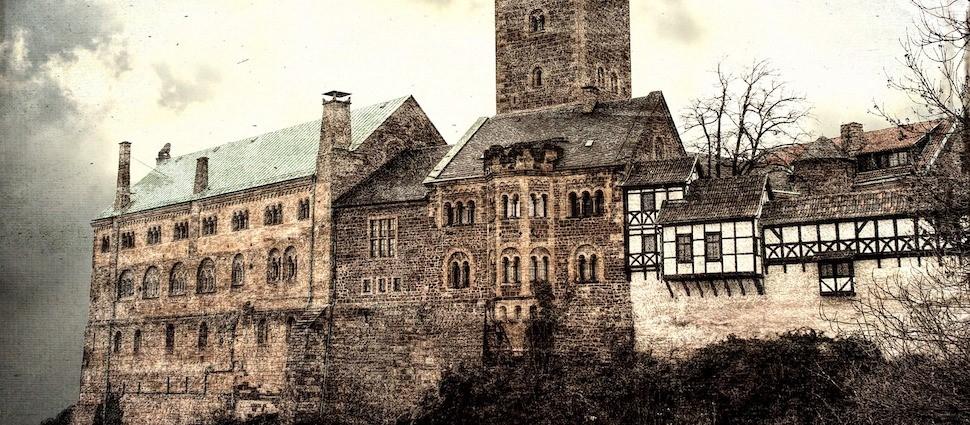A Healthy Church: A Family that Eats Together...

One of the more visible repercussions of the Protestant Reformation was a reconfiguration of the furniture found within local churches. Throughout the Medieval period it was the Table of the Eucharist that sat center-stage, the literal and liturgical focal point of the Roman Catholic Mass. It was there in the bread and cup where Christ was offered and found, ex opere operato. In fact, the more masses held, the more one could benefit from Christ’s merits. But due to the Reformer’s recovery of the Gospel, the word became central again. It was there in God’s living and active word where Christ was found, and we could be found in Christ by responding to His word through faith, alone! Thus the pulpit now took center stage and the sermon, centered on the person of Christ, became the central event of a church’s worship.
The Reformers though still held the sacraments in high regard. They of course reduced the number from Rome’s seven to a more biblical two: Baptism and the Lord’s Supper.[1] To the Reformers, these two sacraments joined the right preaching of God’s Word and Church Discipline as forming the three marks of a true church. Thus John Bradford (martyred July 1st, 1555):
“If, I say, we behold the face of the popish church, Lord, how it glistereth, and gorgeous it is in comparison of Christ’s true church! which is discerned in these days but by the word of God truly preached, the sacraments purely ministered, and some discipline...”[2]
Or again, Nicholas Ridley (martyred October 16th, 1555):
“The marks whereby this church is known unto men in this dark world, and in the midst of this crooked generation, are these: the sincere preaching of God’s holy word, the due administration of the sacraments, charity, and faithful observing of ecclesiastical discipline, according to the word of God.”[3]
Thus, for the Reformers, the sacraments were a central component to being a biblical church. And if they rightly returned the pulpit to being the central piece of furniture in their liturgy, they only slightly moved the table. Sadly in many evangelical churches today, the sacraments are nowhere to be found! There are no tables any more.[4]
Why are Baptism and the Lord’s Supper so essential to being a true, biblical church? Well, firstly because it is biblical - Christ has commanded it! (Matthew 28:19-20 and Mark 14:22-25).[5] And since it is his church, the worship and boundaries of the church are set and delineated by him. The church must obey. And that is exactly what we see in the early church: “So those who received his word were baptized, and there were added that day about three thousand souls. And they devoted themselves to the apostles' teaching and the fellowship, to the breaking of bread and the prayers” (Acts 2:41-42).
It is precisely here, in how Christ has delineated the boundaries of the church, where we see the wisdom of Christ in Baptism and the Lord’s Supper. Baptism, the outward and visible sign of the inward reality of dying with Christ and being raised to new life in Christ,[6] is also the church’s public affirmation of that reality.[7] The baptized person is passively baptized by the church and thus counted by the church to now be a fellow member in Christ’s covenant community, a member of Christ’s body.
Here then is the front door entrance into the church, a door that is opened and closed by the church (Matthew 16:18-19; 18:18-20; John 20:23). Likewise, church discipline is the church’s backdoor which is opened for those who, by a lack of repentance, are evidencing themselves to be unbelievers and not in submission to Christ.
Moving from the blueprints of the church’s front door (Baptism) and back door (church discipline), we can now look at that essential piece of furniture, the Table. What blessing awaits those who walk through the front door of Baptism? Well, if Baptism is the means of grace by which a person is brought once and only once into the church, then the Lord’s Supper is that means of grace by which church members continually identify with and find nourishment in Christ. It is a spiritual feeding upon Christ by faith, signifying the believers union with Christ as well as with the church body.
The Christian is not only looking back to what Christ accomplished in his death, his broken body and shed blood, but Jesus is also clear that the Eucharist looks forward to that final banquet in glory when the Bride shall be fully and finally united with her Bridegroom. It is a worshipful declaration of who we are in Christ the Lamb and who we will be in Christ the coming Lion. This is why the Table is restricted to those who are in submission to Christ; it is Christ’s communion now with his own. Hence again the back door of church discipline often being referred to as excommunication, a cutting off from the Communion Table.
Here we see then the blueprint and essential furniture of Christ’s Church - the delineated boundaries of the church set by Baptism and Church Discipline and the two central pieces of furniture, the Pulpit and the Table. The Sacraments of Baptism and the Lord’s Supper are those special means of grace by which a person is once brought into communion and then continually enjoys communion. And by faith all is centered on the glorious person of Jesus Christ, the church’s Head, her Bridegroom, her King and Savior.
Stephen Unthank (MDiv, Capital Bible Seminary) serves at Greenbelt Baptist Church in Greenbelt, MD, just outside of Washington, DC. He lives in Maryland with his wife, Maricel and their two children, Ambrose and Lilou.
[1] “As far as anyone knows, [Peter] Lombard invented this number. Seven was often used for holy things, and it represented the perfection of God’s gifts, just as the seven-day week represented the perfection of his creation.” Gerald Bray, “Late-Medieval Theology” in Reformation Theology: A Systematic Summary (Crossway, 2017), p.68.
[2] Found in The Reformation of the Church: A collection of Reformed and Puritan documents on Church issues, edited by Iain H. Murray (Banner of Truth Trust, 1997), p. 17.
[3] ibid. p. 19.
[4] Sadly, neither is the pulpit. There must certainly be some connection in the disappearance of actual pulpits in many churches and the demise of biblical, expositional preaching. Instead of pulpits we see stools and instead of preachers we find comedians or self-help life coaches.
[5] See also Acts 2:38, 41; 8:12-13,16; 8:36,38; 9:18; 10:47-48; 11:14; 16:15, 30-33; 18:8 for Baptism and Matthew 26:26-29; Luke 22:14:-20; 1 Corinthians 11:17-34; Acts 2:42, 46; 20:7, 11; 27:35 for the Lord’s Supper.
[6] We must also note that historically most reformed Protestants have agreed that there really is grace administered through Baptism (and the Lord’s Supper); that it is not merely an outward sign. ”It is, in short, the mystery of the Spirit of God, promised to dwell in the church, and making every ordinance of the Church, whether sacramental or not, the channel for the conveyance of supernatural grace. If we would rid ourselves of this mystery, we can only do so by denying that the Spirit is present in ordinances at all.” James Bannerman, The Church of Christ (Banner of Truth Trust, 2015), p. 511.
[7] I am not dealing here with those distinctions made between Presbyterian and Baptist churches on the nature of the visible and invisible church, nor the covenantal continuity or discontinuity between old and new covenants, nor the distinction made by Presbyterian churches on a formal versus a vital union with Christ. All agree though that there are unregenerate people who apart of the church. If they bear the fruit of being spiritually dead through seen unrepentance, than again all agree, proper church discipline - the back door of the church, should be administered.





